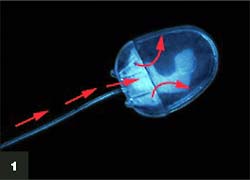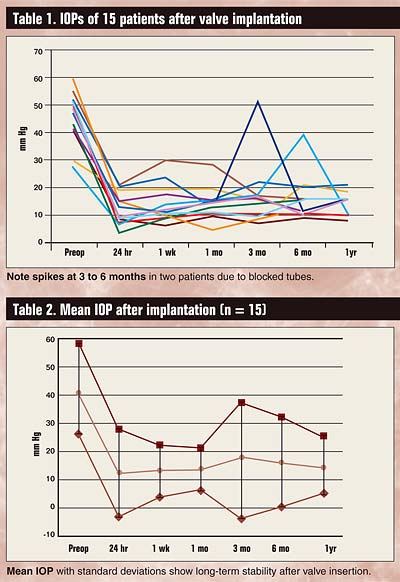Ahmed glaucoma valve a safe option for refractory glaucoma
Study finds a low incidence of postoperative complications.
Glaucoma shunt valves are frequently chosen for the treatment of refractory glaucoma that has been unresponsive to medical and surgical filtration measures. The shunt valves mainly fall into two categories, restrictive and nonrestrictive. The Ahmed glaucoma valve, introduced in 1993, is a restrictive valve. Its structural specifications allow a simple operative procedure, self-regulation and prevention of postoperative complications.
Technique
|
|
A retrospective study was done on 15 eyes of 15 patients who had Ahmed glaucoma valve insertion. The group ranged in age from 29 to 80 years. Seven patients had primary open-angle glaucoma, three had aphakic glaucoma, one had congenital glaucoma, three had rubeotic glaucoma, and one had chronic closed-angle glaucoma. In all cases, vision was worse than 6/60. Preop glaucoma treatment profile included triple therapy with multiple combinations of topical glaucoma drugs in all patients and oral acetazolamide in 10 patients. All patients had multiple trabeculectomy failures, with a mean of 1.6 without antimetabolites. Eleven patients were pseudophakic, three were aphakic, and one was phakic. Five patients had corneal grafts for corneal decompensation secondary to uncontrolled glaucoma, scarring due to chemical injury, disciform keratitis and rheumatoid corneal melting.
For implantation of the Ahmed device, a sub-Tenon's pocket was dissected 8 to 10 mm in the supratemporal quadrant between recti muscles. The body of the valve was stitched to the sclera, and a scleral tunnel was created with a No. 66 Beaver blade, 5 to 8 mm from the limbus, for the valve tube. Priming of the valve was performed with balanced salt solution to check the patency (Figure 1). To avoid corneal touch, the length of tube was beveled forward. The sclera was sutured around the valve tube. Tenon's capsule and the conjunctiva were closed in two separate layers. Routine subconjunctival injection of antibiotic and steroid was given. Mr. Gibran performed all the implant insertions.
All patients received a tapering course of topical antibiotics and steroids for approximately 6 weeks. IOP measurement and slit-lamp biomicroscopy were performed at 24 hours, 1 week, 1 month, 3 months, 6 months and 1 year.
Results
The patients were followed for 1 year. The table summarizes mean preop and postop IOP with minimum and maximum values.
The most common perioperative complication was mild hyphema in two cases that resolved without intervention.
|
|
Postoperative complications were moderate hyphema in two cases. In two patients, the tube blocked 3 to 6 months postoperatively (Table 1). This required washout of the tube through the anterior chamber, with swelling of the bleb during washout being considered a reliable sign of valve functioning. Localized corneal edema was observed in two cases, requiring tube shortening. In one patient, the valve extruded through the conjunctiva. IOP in one patient remained uncontrolled, requiring insertion of a second Ahmed glaucoma valve in the same eye inferonasally to control IOP. Double topical therapy was instituted in two patients to control IOP.
Table 2 depicts the long-term stability of IOP with the Ahmed glaucoma valve with standard deviations and includes the IOP spikes in the two eyes with blocked tubes.
Discussion
|
|
The Ahmed glaucoma valve is a restrictive device. The complications reported with other restrictive valves have not been observed with it. This study shows that the Ahmed glaucoma valve is a safe option for refractory glaucoma, as it is relatively easy to insert and has a low incidence of postoperative complications.
As described previously, there is no vigorous manipulation of ocular tissues. In one eye, extrusion through the conjunctiva occurred. In this case, a scleral tunnel was not created for the tube of the valve. This suggests the importance of the scleral tunnel to prevent extrusion. Pericardial or dural patch reinforcement is not necessary, provided that Tenon's and conjunctiva are closed in two separate layers.
We observed a low risk of complications with the Ahmed glaucoma valve. Only two patients with blocked valves required washout of the tube. It was uncertain if the blockage was due to adhesion of the valve membrane or to precipitates from the aqueous humor. In two cases, localized corneal decompensation ensued secondary to the long tube. Forward adjustment of the tube with a bevel is a good preventive measure in view of this problem (Figure 2). In one patient, insertion of a second Ahmed glaucoma valve was needed to control IOP. Two patients required double topical therapy to lower IOP.
In summary, ease of insertion with a low incidence of preoperative and postoperative complications suggests the Ahmed glaucoma valve may be a safe option in nonresponsive end-stage glaucoma patients.
For Your Information:
- Sylvia Jungkim, FRCSI, S.K. Gibran, MSc, FRCS, and A. Murray, FRCS, FRCOphth can be reached at Department of Ophthalmology, Cork University Hospital, Wilton, Cork, Republic of Ireland; +353-21-4922654; fax: +353-21-4922656; e-mail: syljungkim@eircom.net.
References:
- Ayyala RS, Zurakowski D, et al. A clinical study of the Ahmed glaucoma valve implant in advanced glaucoma. Ophthalmology. 1998;105(10):1968-1976.
- Law SK, Kalenak JW, et al. Retinal complications after aqueous shunt surgical procedures for glaucoma. Arch Ophthalmol. 1996;114(12):1473-1480.
- Davidovski F, Stewart RH, Kimbrough RL. Long-term results with the White glaucoma pump-shunt. Ophthalmic Surg. 1990;21(4):288-293.
- Coleman AL, Hill R, et al. Initial clinical experience with the Ahmed Glaucoma Valve implant. Am J Ophthalmol. 1995;120(1):23-31. Erratum in: Am J Ophthalmol. 1995;120(5):684.
- Brandt JD. Patch grafts of dehydrated cadaveric dura mater for tube-shunt glaucoma surgery. Arch Ophthalmol. 1993;111(10):1436-1439.



